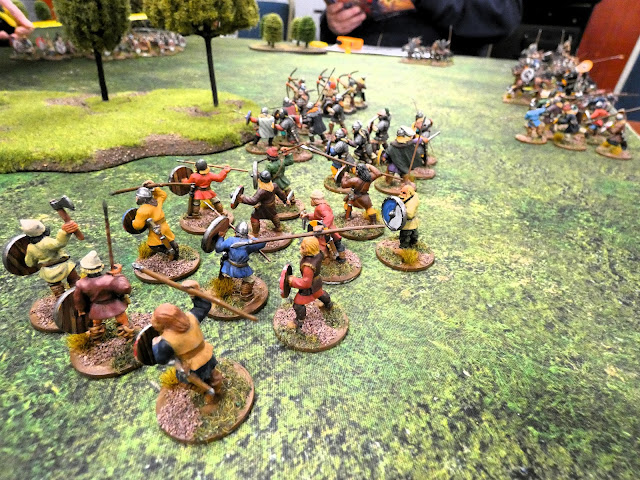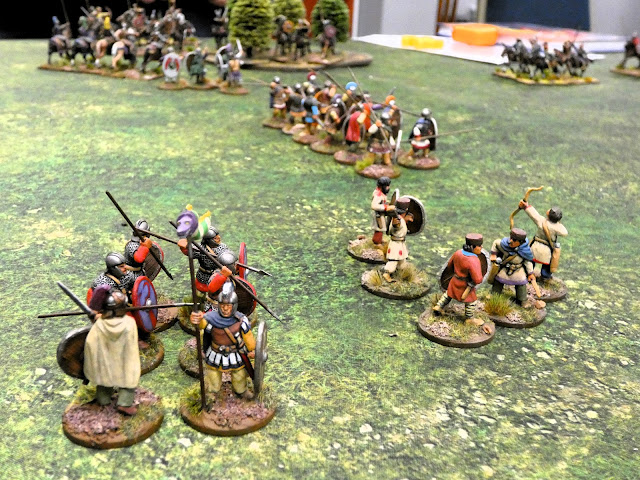The new wargaming year got off to a cracking start when Mike C offered to bring his lovely collection of late Romans and opposing barbarians to run a Lion Rampant (LR) set-to at club this month based on the scenario 'Hammer and Anvil'.
I still refer to my first edition copy of LR, and must update myself with the newer second edition at some time, but found the rules just as fun as the first time I played them, perhaps more towards the game parameter rather than simulation, but still a well crafted set of rules that produced a gripping narrative of a game.
 |
| Our table set up with the Roman infantry in the centre and their cavalry and supporting light infantry nearest to camera. At the opposite end of the valley are the approaching Goths and Huns |
 |
| The Goths and Huns, full of bravado after a, so far, successful raid into the Empire, advance up the valley with a mixed force of infantry and bow armed cavalry |
 |
| Gothic light infantry move into the woods flanking the valley sides |
 |
| The Gothic-Hun force are very mobile with plenty of missile troops as well |
 |
| The Roman shield wall braces itself for the impending assault as their cavalry advance up the valley to their support. |
The scenario creates a great struggle as the barbarians attempt to force their way up the valley by either breaking Roman units already in their way, attempting to hold them up, or using their rapid movement capability inherent in a light cavalry force to exploit gaps to either escape off table or support the struggle in the centre.
However with fresh Roman units, mainly cavalry, entering the table at either end, the Gothic-Hun force have to be wary of becoming to embroiled in the fight and forgetting their mission objective, namely to escape off table
 |
| Roman heavy cavalry come up at the canter. |
Similarly the Roman force is looking to fight and win as many struggles as possible by routing enemy units, but are forced to spread themselves thinly initially to plug potential escape routes, with the cavalry acting like fire brigade units moving back and forth to plug gaps or aid in the destruction of an enemy units brought to battle.
Inevitably gaps in the line occur and the units end up too busy fighting elsewhere to plug them all and so the game develops into a struggle for both sides to put points on the scoreboard with early victories.
 |
| The Roman infantry are forced to spread their line to contest the passage of enemy units. |
Our game followed the script closely, with the Romans scoring some early victories that forced the Goths and Huns to fight and destroy Roman units to create gaps in the line, which created choices for the Romans as to when and where to put their units into fights to attempt to overwhelm opposing enemy units, or to leave a fight in the balance to free up a unit to move to fill a gap in the line.
 |
| As the Huns and Goths press forward the trap is sprung as the first pursuing Roman units enter the valley in their rear. |
As the game progressed more and more units were removed from the table either as battle casualties or as escapees, with the final fights producing a close finish as both sides looked to see how many successes they had accumulated and where another potential success beckoned, with the last few remaining barbarian units moving at flank speed for the nearest exit, whilst Romans sought to overwhelm those not quick enough to join the withdrawal.
 |
| Roman heavy cavalry come on in pursuit of a Hun unit. |
As it turned out, after the dust of battle had settled, the game ended in a draw with equal points gained by both sides, but with the Romans paying a dividend on their hard earned result, with both their commanders in the infantry and cavalry making the supreme sacrifice for the Empire.
 |
| The battle reaches its close with the Roman infantry thinned out but not beaten but with Roman cavalry forced to ride to their right flank looking to cut off escaping enemy units. |
Thank you to Mike for hosting a splendid game to start the new year on and to Steve M, Nathan and Sam for creating the drama of our game.
JJ




For Late Roman infantry, we allow units to throw plumbata just before a melee as follows: roll 6 dice if attacking, or 3 dice if defending (hits on 5s & 6s). Opposing unit adds these hits to any subsequent hits. For their barbarian adversaries, there is a 2" movement bonus for all units and all light troops are 'ha4d to target' and 'fleet-footed."
ReplyDelete